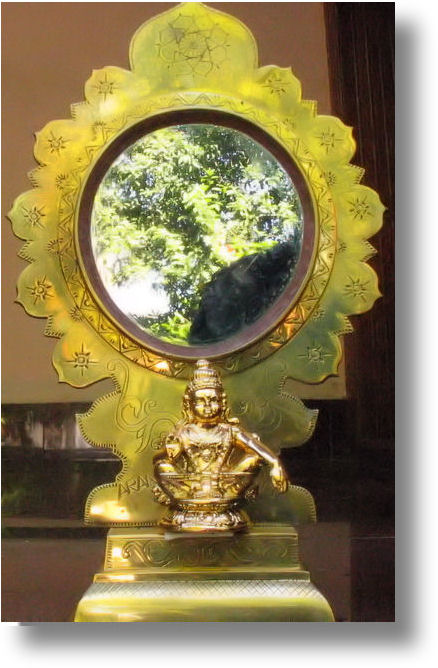The famous 'Aranmula Kannady' is
made in Aranmula village In Kerala State
,India by the traditional
craftsmen. It is not made of glass but with bell metal. This is a unique
art which is not found any where else in the world. Its
techniques is handed down from generation to generation.

The Aranmula Metal Mirror is a unique
object, mysterious in its creation unequalled in its beauty. The metal
mirror, a marvel in the
annals of metallurgy was in vogue long before the appearance of
today's Silicon synthetic glass mirror.It was in
use far off Egypt and Bagdad. Its creation is a closely guarded secret,
known to a few
families
Aranmula Metal Mirror
manufacturing was staged in the early 18th century. It represents a
fascinating area of culture and technological curiosity. Mysterious in its
creation, unequaled in its beauty, this metal mirror, a mediaeval
Dravidian marvel in the annals of metallurgy was in vogue long before the
appearance of today's silicon glass mirror. This is constrained to only
one household of master craftsmen in Aranmula. The origin of metal mirror
of Amnmula is closely connected with the Aranmula Padhasarathy Temple
which is deemed to be the nerve centre cf Pamba valley civilization. The
art of making metal mirror has been practiced in the various parts of the
world.
Sree Parthasarathy temple,Aranmula
Aranmula is traditional Village in
Pathanamthitta district ,Kerala State India And about 110KM North from
Trivandrum ,the State Capital and 125 Km South from Cochin.
Aranmula is famous for Aranmula Metal Mirror) and the centuries
old Vaishnavite Temple , the Sree Parthasarathy temple on the banks of the
Holy River Pampa, is fast turning into a cultural tourism centre in
the State with growing number of foreign
tourists visiting the place. Every year, tourists from Australia, Canada,
England, Switzerland, besides many other European countries reach Aranmula
TRADITION
The legend has it, that
eight families of expert in temple arts and craft had been brought by the
local Royal Chief of Amnmula from Sankarankoil situated in the present day
Tirunelveli District of Tamil Nadu in connection with certain works in the
Parthasarathy Temple centuries ago. While working with the bronze to make
a crown for the Lord Parthasarathy, to their surprise the artisans
discovered the reflective property of one particular copper-tin alley.
However they failed to reproduce the compositions. The oral history
continues to say that a divine interference came from Parvathi Amma, a
widow of community, through a dream. She received a secret ratio of the
alley. There is a story in Puranas, that, the mirror of Godess Parvathi ,
is a diva Vasthu which symbolizes pact with God.
|
No comments:
Post a Comment